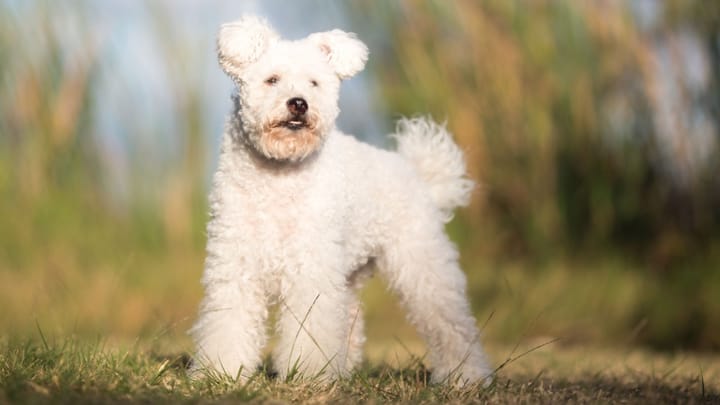Pumi
Other names : Hungarian Pumi, Hungarian Herding Terrier

The Pumi originates from Hungary and has become famous all over the world for its quirky, teddy-bear-like looks. Originally bred to herd livestock, this is a highly energetic and intelligent breed which thrives as part of an active family. Naturally protective and loyal, the Pumi forms strong bonds with its family and makes for a lovely companion.
|
Life expectancy |
The Pumi has a life expectancy of between 12 and 14 years |
|
Temperament |
|
|
Size |
Medium
|
|
Adult size |
Female
Between 15 and 17 in
Male
Between 16 and 19 in
|
|
Adult weight |
Female
Between 18 and 29 lb
Male
Between 22 and 33 lb
|
|
Coat colour
White, grey, black or fawn. |
Black White Blue Brown |
|
Type of coat
Wavy or curly, and dense. |
Long |
|
Eye colour
Dark brown. |
Brown
|
Although they are sometimes referred to as Terriers, they are not related to Terriers. They are simply comparable in terms of their alert natures and robust constitutions.
More details about the Pumi
Pumi: Origins and history
A descendant of the high-energy Puli breed and a touch of terrier, the Pumi originates from 17th century Hungary, where she was used by shepherds to herd cattle, sheep and pigs. She has since remained the most popular herding dog in Hungary but has gained popularity in other countries too, mostly down to her adorable, koala-like looks.
Physical characteristics of the Pumi
The Pumi is a medium-sized, compact dog that is often compared to a koala bear - yes, really! This cute-looking breed has an extremely long muzzle, semi-erect ears, dark brown, wide-set eyes and a jolly facial expression. The body is square-looking but small, and fairly muscular for its size.
FCI classification of the Pumi
-
Group 1 - Sheepdogs and Cattledogs (except Swiss Cattledogs)
-
Section 1 : Sheepdogs
Pumi: Characteristics
Pumi: Behaviour
Training a Pumi
The Pumi is intelligent and can pick up new tricks and follow orders with ease. However, the independent streak means training should start early.
Pumi: Lifestyle
Breed compatibility Pumi
Pumi: Purchase price
They are fairly hard to come across in the UK, but you can expect to pay upwards of £1000 for a KC-Registered dog. Looking after a dog of this size typically costs between £50 to £80 a month, including food, medical/insurance, and incidental expenses.
Pumi: Grooming
The Pumi’s glorious coat requires a good comb around once a month. It’s essential to wet the coat down after brushing and let it air-dry naturally to retain the lovely, natural curl. Many Pumi owners also prefer to trim the coat to keep it under control.
Pumi: Health
Generally a healthy and long-lived breed, with an average life expectancy of 13 years.
Fairly muscular and agile for her small size.
Tolerates both hot and cold temperatures, though not to extremes. She shouldn’t be overworked during times of heat wave.
Tolerates both hot and cold temperatures, though not to extremes. She should live indoors in winter.
The Pumi isn’t known to be excessively prone to weight gain, though it’s still essential to keep an eye on her weight and adjust daily calorie intake sizes if necessary.
- Elbow dysplasia
- Hip dysplasia
- Patellar luxation
- Degenerative Myelopathy
- Eye disorders




